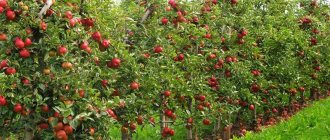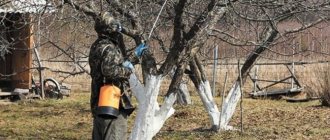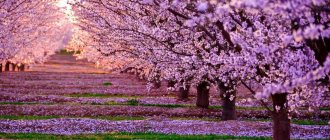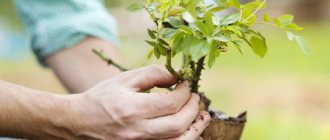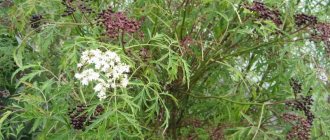Not every summer resident can boast of a large area for growing garden crops. That is why dwarf trees for the garden, which are distinguished by their miniature forms, but at the same time high levels of productivity, are increasingly being chosen for small plots. In addition to fruit trees, there are also a large number of ornamental plants that will fit perfectly into the landscape design, decorate the site, and make it more refined and harmonious. In this article, we have prepared for you information about the features of growing dwarf crops, and also made a selection of the best fruit and ornamental trees.
How to plant dwarf fruit trees in the garden
Dwarf trees are planted differently than ordinary trees. Planting work is allowed only in spring.
In low varieties, preference is exclusively given to fertile soil. If the site has unsuitable soil, then you have to do the following:
- Dig a hole 1.5 m deep and 1 meter wide;
- The earth that was dug up is taken to another place, the site itself is leveled;
- Then the area is filled with fertile soil.
It should also be taken into account that the best place for planting is considered to be areas where groundwater is located close to the surface. This is due to the fact that the root system of miniature trees is located in the upper part of the soil, and therefore is not able to penetrate more than 1 meter.
It is better to give preference to elevated areas or slopes with good illumination by ultraviolet rays. Before planting, the root system is placed in water to fill it with moisture.
A hole is formed in the ground that has been prepared for planting (50 cm deep and 70 cm wide). Humus is placed at the bottom (1 bucket is enough), then a layer of soil is poured in, and then water is spilled. As a result, a slurry is formed, where the seedling is placed.
Having positioned the seedling so that the root system protrudes above the surface, it can be covered with soil. Then a tree trunk roller is formed from the soil - 10 cm high. Mulching is also a prerequisite.
When you purchase a low plant from a nursery, consult with the seller about proper planting and further care of this variety of dwarf crops.
Scheme of planting several trees
When planting several low-growing trees, you should maintain a distance of 2 meters from each other. It is also extremely important to form a peg and tie a wooden trunk to it using a narrow elastic band.
Maple
Most varieties of this plant are 10-40-meter giants, which, if used in gardening, are used exclusively for landscaping large areas. However, among these maples there are also compact ones that will become a real decoration of your garden.
Maple Crimson King
The Crimson King maple is a relatively low (10-15 m) tree, the foliage of which is similar in shape to the leaf blades of the familiar Norway maple, bright red in the spring, crimson with a purple tint in the fall. Prefers sandy and loamy soils with a reaction ranging from slightly acidic to slightly alkaline. Does not tolerate stagnant water well.
Osakazuki Maple
Osakazuki maple (Osakazuki) is a low 4-6-meter tree with an annual growth of 15-20 cm. In spring, the leaves have a rich green color, which by autumn changes to dark orange or bright red. Despite the fairly high growth rate of shoots, it requires almost no pruning.
Senkaki Maple
Senkaki maple (Senkaki) is a tree 2-6 m high. Young shoots are distinguished by their bright coral color. The leaves are deeply dissected with 7-9 lobes, colors are light green in spring, canary yellow in autumn. Loves sunny places and slightly acidified, well-drained soils. Tolerates frosts down to –27°C.
Fruit dwarf trees for the garden
Let's look at several well-known varieties of miniature trees with varieties.
Apple trees for a miniature garden
The most popular among summer residents are dwarf apple trees for the garden. They produce a good harvest and are easy to care for.
Among the early ripening varieties there are:
- "Candy" The fruits are distinguished by a yellow-green hue, firm, but juicy pulp. Fruit ripening occurs in August, apples weigh 120 g.
- "Wonderful." Trees begin to bear fruit in the 4th year from the moment of planting. The plants are frost-resistant and have a high yield. The fruits are large with a yellowish tint, but with red splashes. The taste is honey.
- "Melba". It is considered a super early variety. They bear fruit in July and are highly productive. Medium fruits with a juicy caramel taste.
- "Suislep". Bears fruit for 3 years. The apples are colored pinkish-yellow. Such fruits weigh up to 100 g.
Mid-season popular varieties of dwarf apple trees:
- "Autumn striped." The weight of such fruits is up to 200 g. They are distinguished by their bright yellow hue and sweet and sour taste. Another plus is that fruits store well.
- "Zhigulevskie". It is considered one of the most resistant varieties. Distinguished by red fruits. They bear fruit in the 2nd half of September. Very well used for sale.
- "Sokolovskoe". A high-yielding variety, up to 90 kg of fruit can be obtained from one tree. They are sweet and sour and have a greenish tint.
Among the winter dwarf varieties, “Bogatyr” should be highlighted, which is not afraid of various types of weather changes, but requires systematic pruning of branches. The fruits are elongated, red-yellow in color.
The Snowdrop variety is also popular. They are round in shape and colored yellow. One fruit weighs up to 150 g.
Dwarf Pears
The most common varieties are considered to be “Grand Champion”. This is a high-yielding variety with large fruits. The pulp is oily, sweet and quite juicy. This species is also frost-resistant.
Another popular variety is “Veles”. The pear has a round shape and a greenish tint. One pear weighs up to 200 g. Also popular is the “Parisian” variety. The fruits ripen before winter, have a sweet and sour taste, and are large in shape. This fruit is colored green-yellow.
Varieties of miniature plums
Among plum trees, Blue Free is considered the most popular. He is precocious. The color of the fruit is inky black, the shape is oval.
The Chachakskaya variety is also popular. Late ripening variety. The creamy pulp of the fruit has a sweet and sour taste. The “President” variety is also found in miniature gardens. It is distinguished by its unpretentiousness, high-quality harvest, and high commercial characteristics.
Popular short Peaches and Apricots
These trees reach a maximum height of 2 meters. Most popular:
- "Sweet Cap." Winter-hardy variety with a high level of fruiting. The pulp is white and the taste is very sweet.
- "UFO". Also a miniature fig tree, it is resistant to diseases. It is distinguished by sweet fruits, large and juicy.
Among apricots, it is worth paying attention to the “Hardy variety”. It is distinguished by large fruits and seeds, which are easily separated. The pulp is orange, sweet, and has a rich orange color. The medium-ripening variety “Crimean Amur” has also proven itself very well. It is distinguished by large apricots, they weigh up to 100 g. They have a light orange tint and taste sour.
Dwarf Cherries
Slender and beautiful cherries are popular among all summer residents.
The most popular are:
- "Anthracite". It grows like a bush and reaches a height of up to 2 meters. Needs systematic pruning and crown shaping. Shelter will be required for the winter season. It looks very decorative when the black berries ripen.
- "Dwarf". It has large berries, each of which weighs up to 5 g. The fruits have a dark burgundy hue and are oval in shape.
- "Youth" The fruits have a neat shape and are colored dark burgundy. Weigh up to 5 g.
Classification
In landscape design, decorative deciduous and decorative flowering, deciduous and evergreen trees are used. The first category includes low-growing birches, maples, willows, and elms. With the arrival of autumn, their beauty reaches a new level as the foliage takes on rich shades of purple or yellow.
Unlike deciduous species, decorative frost-resistant trees - cedar, fir, juniper, pine, spruce and other representatives of the “coniferous family” - retain their beauty unchanged all year round (the only exception is larch, which sheds its needles for the winter). When designing plots, landscape designers play up the difference in the size of the crown and the color of the needles. Representatives of the conifer genus provide the additional benefit of aromatizing, disinfecting and purifying the air.
Equally interesting are evergreen deciduous plants: euonymus, barberry, magnolia, rhododendron, boxwood, cherry laurel. The main disadvantage is the need for more serious care - most of them need protection from the cold and do not grow in all regions.
Lavrovishnya
The decorative flowering category includes rhododendron, kölreuteria, sakura, albizia, European cercis, and rowan. When choosing medium- or tall-growing flowering trees, it is worth remembering no less spectacular shrubs, such as viburnum, serviceberry, almond, Japanese quince, kerria, spirea, lilac, elderberry, cotoneaster, rose hips, yew, deutzia. They complement the composition, creating a lower tier.
How to care for a fruit “mini garden”
The basic rules of care include systematic loosening of the soil, removal of weeds and other vegetation. To avoid the appearance of crusts on the ground, you will need to mulch the soil. Compost is used for such purposes.
Particular attention is paid to the soil during the dry season. To retain moisture, the soil is covered with hay. Mulching is carried out so that the layer is not located too close to the trunk. It is not recommended to apply mulch during wet periods.
Watering
It is recommended to water the mini garden weekly. 2 buckets of water should be added to 1 seedling.
Fertilizers
It is best to fertilize after the soil is moistened. For dwarf plantings, fertilizing with mullein or chicken manure is ideal. It is recommended to dilute mullein with water in a ratio of 1 to 10, and chicken droppings - 1 to 20.
Diseases
Most often, gardeners encounter powdery mildew, mosaic and cytosporosis. The first disease manifests itself in the form of a white powdery coating. This is a fungal disease that progresses quite quickly. Fruits on such trees may not bear fruit and may become deformed. As preventive methods, it is recommended to carry out systematic pruning, remove debris and fallen fruits. Thickening of the crown is not allowed. In spring, it is recommended to spray with Bordeaux mixture. If the plant is damaged, it is recommended to remove all damaged parts and burn them. It is also recommended to use the preparations “Tiovit Jet”, “Topaz”, “Quadris” for treatment.
Mosaic appears as green or white spots on leaves and fruits. This is a disease of viral origin. Leaves may become deformed and development may slow down. Often the disease occurs due to treatment with instruments that are not disinfected. Minor damage can be treated with Karbofos.
Cytosporosis is manifested by brown shades of the crown, the appearance of bumps and roughness. Treatment will only help in the early stages. All damaged areas are removed and burned. Then the trees are treated with Bordeaux mixture, also fed with ash and whitened with lime.
Properly selected dwarf trees for the garden will harmoniously complement a small area, fill it with beauty and provide fruit.
Cercis (European purple grass)
Bagryanniki are inhabitants of the Mediterranean, North Caucasus, Middle East and Transcaucasia. However, even those trees that continue to grow in their historical homeland reach heights of 11-12 m closer to a hundred years. Flowering is abundant, before the leaves bloom, fruits - beans - appear closer to September.
Unfortunately, the climate of the middle zone is not very suitable for this plant, however, purple flowers bloom and bear fruit quite successfully in the Rostov region and the steppe regions of the Krasnodar Territory.
Trees that are undesirable in a garden plot according to ancient legends
Before planting a tree in front of your house, you can turn to the experience of our ancestors. At first glance, all signs are based on superstitions, but they often have a logical grain.
It is not recommended to plant an oak tree on a summer cottage, which has strong energy and influences the head of the family. Birch as a protective shield should only grow behind a fence. Walnuts should not be planted near the house, as their roots can eventually destroy the foundation. Willow, willow and aspen, the messengers of sorrow and death, are undesirable on the site.
If there are brides in the family, then it is also better to wait to plant thuja. It is recommended to plant poplar outside the site, away from the house.
Hawthorn
Many gardeners underestimate the decorative qualities of hawthorn, believing that this widespread shrub, blooming with small white flowers, is only suitable for arranging hedges. In fact, there are a huge number of varieties and hybrids of this plant. Breeders have managed to develop not only “fruit-bearing” varieties of hawthorn, which are grown to produce berries, but also trees with unusual flower shapes and colors.
Hawthorn Paul Scarlet is a fast-growing tree or shrub up to 4-6 m high, annual growth is 25 cm in height, 15-20 cm in width. The flowers are double, carmine-red in color, open in May or June. Frost-resistant, loves moist but well-drained soils.
- Why do you need hawthorn in your dacha - 7 ways to use an unpopular shrub
Still think that hawthorn is a shrub for a city park? Then this article is just for you!
Holly
Holly Golden King
Golden King Holly is a relatively short 3-5 meter evergreen tree with bicolor leaves and red-orange berries that remain on the tree until almost spring. Like the vast majority of hollies grown in the midlands, during cold winters they may need additional shelter.
Holly Argentea marginata
Holly Argentea Marginata stands out for its unusual leaf color. Because of the pale yellow edging, it seems that the leaves are dusted with frost. It grows slowly, but tolerates formative pruning well.
Lawson's cypress
Lawson's cypress Ellwoodii is a low tree with a compact cone-shaped crown. It grows slowly - no more than 5 cm per year. The color of the crown is green-blue, turning to steel in winter. Practically does not require pruning (except for sanitary purposes), but requires obligatory shelter for the winter. Suitable for growing indoors.
- Thuja, juniper, cypress, thuja and cypress - learning to distinguish between representatives of the Pine
You planted “something coniferous” on your property, but now you can’t figure out what exactly has grown? Let us help you understand and find out!
Timing of tree planting and purchase of seedlings
It is difficult to unequivocally answer the question of when is the best time to plant trees. It depends on weather conditions and the specific crop. The optimal time for planting fruit trees from the pome group is late autumn, and for heat-loving stone fruits it is better to plant them in early spring. The preferred age of seedlings is 2 years, but for vigorous crops (pear, cherry) it is better to use annual seedlings. The negative side of annual seedlings is their unformed crown, but they suffer less pain when transplanted and take root faster.
Most ornamental crops are planted in spring. Moreover, the strict limits “before bud break” apply only to seedlings with an open root system. Planting material with a closed root system (in pots or bags) is suitable for planting throughout the spring and even in summer, but it is more expensive.
When purchasing seedlings at specialized exhibitions and fairs, you need to pay attention to the following points:
- in what form they are sold: seedlings with exposed and dried roots have little chance of taking root on the site; good material is packed in bags with a small lump of damp earth;
- condition of the root system: roots should be smooth (without thickening), elastic and without signs of peeling;
- crown condition: the buds should be swollen, but not bloomed;
- trunk height: for 2-year-old fruit seedlings about 50 cm;
It is recommended to buy planting material from nurseries that exist in each region. Only there can you be sure of the quality of the seedlings and choose plants adapted for a specific zone. Varieties of fruit trees for the Moscow region and the entire central zone of Russia are grown in the Michurinsky fruit nursery.
Low plants for a small area
If it is necessary to improve a small area in the garden, then low-growing plants will be the best choice for planting. Plants such as ivy and hops . These plants will cover all the necessary areas.
You can safely use flowering plants for weaving. They will look especially beautiful and elegant at the entrance to the courtyard, while emphasizing the front part of the courtyard. Different configurations of supports for planting such plants will help create an even more beautiful decorative appearance.
Bobovnik Waterera
Bobovnik Vaterera Vossii (Vossii) is a tree 4-9 m high and a crown diameter of 3-4 m. Yellow flowers are collected in large 15-25-centimeter clusters. The fruits are pubescent beans, ripen in August-September. In places of natural growth (Central Europe) it blooms from May to June. In the middle zone, the start may shift to a later date, because In winter, the plant often freezes over and needs time to recover. It is light-loving and drought-resistant.
All parts of the plant are poisonous!
When choosing plants for your garden, you should not limit yourself to the usual solutions!
Cherry tree
Cherry has long been associated with the beginning of life, its earthly embodiment. It is symbolic that the tree is covered with flowers before the leaves appear on it. For many peoples, cherry blossoms symbolize the outfit of a chaste bride.
Branches of cherry blossoms used to be used in girls' fortune telling for love. Unmarried women plucked a cherry branch on the night of December 7 (the day of the Great Martyr Catherine, who patronizes single girls) and placed it in a vase of water. If the branch bloomed for Christmas, then the girl was predicted to get married soon.
Cherry generously shares its energy with the inhabitants of the house: it is a donor tree. It helps to improve relationships between spouses and brings prosperity and prosperity to the home.

